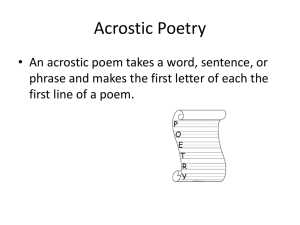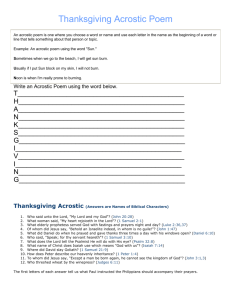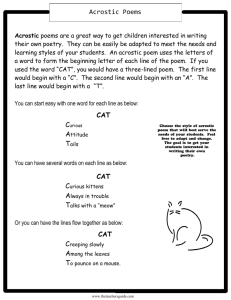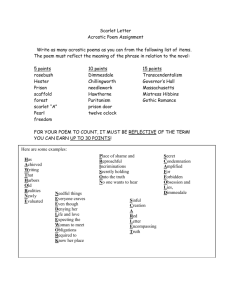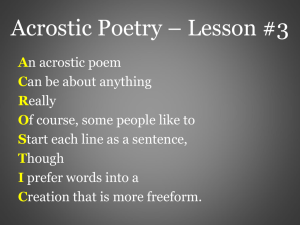Acrostic Translation in the Invocation Prayer
advertisement
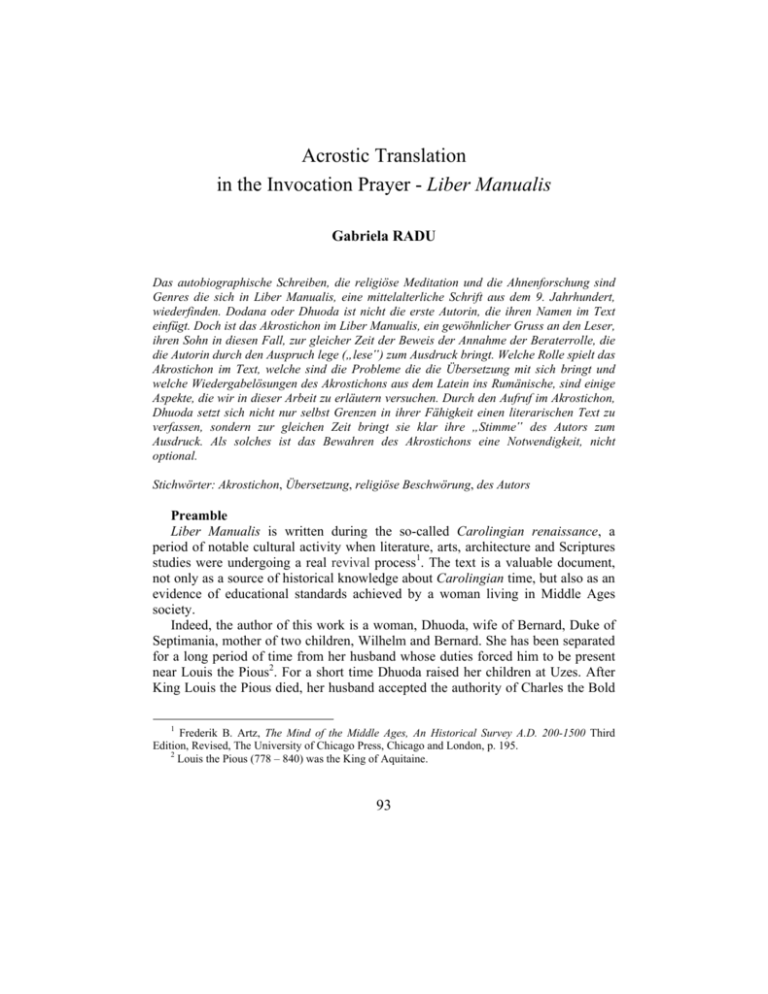
Acrostic Translation in the Invocation Prayer - Liber Manualis Gabriela RADU Das autobiographische Schreiben, die religiöse Meditation und die Ahnenforschung sind Genres die sich in Liber Manualis, eine mittelalterliche Schrift aus dem 9. Jahrhundert, wiederfinden. Dodana oder Dhuoda ist nicht die erste Autorin, die ihren Namen im Text einfügt. Doch ist das Akrostichon im Liber Manualis, ein gewöhnlicher Gruss an den Leser, ihren Sohn in diesen Fall, zur gleicher Zeit der Beweis der Annahme der Beraterrolle, die die Autorin durch den Auspruch lege („lese‟) zum Ausdruck bringt. Welche Rolle spielt das Akrostichon im Text, welche sind die Probleme die die Übersetzung mit sich bringt und welche Wiedergabelösungen des Akrostichons aus dem Latein ins Rumänische, sind einige Aspekte, die wir in dieser Arbeit zu erläutern versuchen. Durch den Aufruf im Akrostichon, Dhuoda setzt sich nicht nur selbst Grenzen in ihrer Fähigkeit einen literarischen Text zu verfassen, sondern zur gleichen Zeit bringt sie klar ihre „Stimme‟ des Autors zum Ausdruck. Als solches ist das Bewahren des Akrostichons eine Notwendigkeit, nicht optional. Stichwörter: Akrostichon, Übersetzung, religiöse Beschwörung, des Autors Preamble Liber Manualis is written during the so-called Carolingian renaissance, a period of notable cultural activity when literature, arts, architecture and Scriptures studies were undergoing a real revival process1. The text is a valuable document, not only as a source of historical knowledge about Carolingian time, but also as an evidence of educational standards achieved by a woman living in Middle Ages society. Indeed, the author of this work is a woman, Dhuoda, wife of Bernard, Duke of Septimania, mother of two children, Wilhelm and Bernard. She has been separated for a long period of time from her husband whose duties forced him to be present near Louis the Pious2. For a short time Dhuoda raised her children at Uzes. After King Louis the Pious died, her husband accepted the authority of Charles the Bold 1 Frederik B. Artz, The Mind of the Middle Ages, An Historical Survey A.D. 200-1500 Third Edition, Revised, The University of Chicago Press, Chicago and London, p. 195. 2 Louis the Pious (778 – 840) was the King of Aquitaine. 93 under constraint. He gave his older son, Wilhelm, to the king as a guarantee of his loyalty. Under and through these circumstances and soon after her son was taken in captivity, Dhuoda started composing the Manual. She sent the work to Wilhelm two years later, in 843. It is not known whether the Manual came to be read by its addressee since Wilhelm was killed around 850. Book of advices: imitation versus innovation As a genre Liber Manualis belongs to the category of advice works, a favorite type of writing in western and eastern Middle Ages. What makes this handbook to stand out from the template of such works of advices is the feminine voice that manages to make itself ʽheardʼ beyond the pattern. Although the author follows two traditional genres, the handbook and the mirror, genres that are usually full of scriptural teachings or patristic text quotations, the formal frame is repeatedly eluded. The text of the Manualis is the only way through which Duoda can utter her longing for her son. It is simultaneously, the only maternal image which she is able to offer to her son as it can be seen in the next translated3 excerpt: “I am well aware, that most women rejoice that they are with their children in this world, but I, Dhuoda, am far away from you, my son William. For this reason I am anxious and filled with longing to do something for you. So I send you this little work written down in my name, that you may read it for your education, as a kind of mirror. And I rejoice that, even if I am apart from you in body, the little book before you may remind you, when you read it, of what you should do on my behalf”4. Liber Manualis has been edited by P. Riché in Sources chrétiennes, vol. 225, Paris, 1991. The English translation The Romanian translation was made following this edition. The acrostic – a subdued signature Epistolary autobiography, religious meditation and genealogy are all literary varieties that can be found together in Liber Manualis. From the beginning of the handbook, Dhuoda assumes the authorship as well as the role of the teacher: “The little book before you branches out in three directions. Read it through and, by the end, you will understand what I mean. I would like it to be called three things at once, as befits its contents - rule, form, and handbook. All of these parts of speech appear to be held together 3 The English translation of the text belongs to Carol Neel in Handbook for William A Carolingian Woman's Counsel for Her Son by Dhuoda. Translated and with an introduction by Carol Neel University of Nebraska Press: Lincoln NE, 1991. 4 “Cernens plurimas cum suis in saeculo gaudere proles, et me Dhuodanam, o fili Wilhelme, a te elongatam conspiciens procul, ob id quasi anxia et utilitatis desiderio plena, hoc opusculum ex nomine meo scriptum in tuam specietenus formam legendi dirigo, gaudens quod, si absens sum corpore, iste praesens libellus tibi ad mentem reducat quid erga me, cum legeris, debeas agere.” 94 in our mirror. The rule from me, the form in you. And so the handbook moves from me into you, gathered together by me and assumed within you”5. The message contained in the Liber Manualis’ prologue is followed by invocatio6 Dei, a rhetorical strategy for capturing reader’s attention. In the same time, this strategy evokes the ancient ʽInvocation of the Museʼ. It is formed of seventy-six lines, and interweaves in its content the following message: DHUODA DILECTO FILIO VVILHELMO SALUTEM LEGE (ʽDhuoda sends greetings to her beloved son William. Read!ʼ). Dhuoda is not the first writer who interlaces her own name in the text. At first view, the constraint of acrostic format on the poetic expression could appear as something artificial and out of the context. The acrostic in Liber Manualis is not only a conventional greeting structure7 to Wilhelm, the addressee of her book, but is also a proof that the author assumes her advising role when she urges her son to read the text: lege (ʽRead!ʼ). Besides, the acrostic is a powerful statement of authorship. By using the acrostic, Dhuoda purposely imposes semantic limitations which are designed to demonstrate her ability of composing a literary text. For this reason only, ʽpreservingʼ the acrostic in translation is mandatory, not optional. The origin of the acrostic is not certainly known, although the oldest evidence of its existence can be traced back to the Babylonian prayers. The acrostic is encountered not only in religious hymns, but also in laic poetry8. Between the two types of acrostic, namely the alphabetical9 and the onomastic, in Dhuoda’s handbook the latter is used. In this case, the first letter of every other line, starting with the first, creates vertically a name or a word that reveals the authorial intent. Thus Invocatio Dei is organized of distiches10, out of which only the letter of the first distich forms the acrostic. The authors of many translations incline to disregard the acrostic as an insignificant matter. The recognition of the important role of the acrostic in original text can plead for the necessity of preserving it in translation. It is well known that the acrostic was used as memory aid in religious hymns, as its logical layout was 5 “Praesens iste libellus in tribus virgulis constat esse erectus: Volo enim ut simili modoin tribus lineis secundum auctoritatis seriem utilissimum habeat nomen: id ist Norma, Forma et Manualis. Quod utrumque hae partes locutionis in nos specietenus continentur cuncta: Norma ex me, Forma in te, Manualis tam ex me quam in te, ex me collectus, in te receptus.” Incipit textus 7–12. 6 Origen identifies in the Bible two meanings of invocation (proseuchè): the first more common one as “prayer”, and the second as “promise” (Origen 2006: 37). 7 “Dhuoda stands behind and inside her work, together with her son. Her purpose goes beyond the epistolary conventions of signature and name of addressee.” afirmă în Dhuoda Handbook for her Warrior Son Liber Manualis, edited and translated by Marcelle Thiebaux, Cambridge University Press, 1998, p. 30. 8 Used in Latin for the first time by Cicero, and then by Dionysius of Halicarnassus, the acrostic has become as important as the chorus refren during the first centuries of Christianity. 9 The alphabetic acrostic has emerged in the Christian hymnography through Hebrew tradition (Psalm 118). The first known Greek poet to use the alphabetic acrostic is Methodius of Olympus in Τὸ Παρθένιον. 10 Two lines of poetry, sometimes rhyming, that form a complete unit in themselves. 95 facilitating the ability of learning the text by heart. Even in teaching works, moral and religious exhortations were composed so that they were able to be easily memorized. However the mnemonic function is not the main reason for which Dhuoda has used the acrostic in Invocation. On one hand, Dhuoda uses the acrostic as a poetic way to dedicate this handbook to her oldest son. Hence, it is mandatory to preserve this dedication in any translation attempt as it represents the clear intent of the author to embed the name Wilhelm who is the main addressee of the text. The acrostic represents a part of the communication process that cannot be ignored. On the other hand, by constraining herself to the acrostic use, Dhuoda wants to prove her abilities as a writer to maintain both, the accuracy, and the coherence of the message, in spite of the self-imposed restrictions, all of that within the poetic expression. The explicit desire of the author to make her ʽpresenceʼ known to her son and to make the reader aware of her poetical abilities, in other words, to over-sign her work, leads to the idea that authorship was also an important reason for Dhuoda in choosing the acrostic format. The incitement contained by Invocatio further strengthens the author’s intent: “Reader, if you desire to know the key, / Look at the beginning of each verse”11. Most of the translators know that is almost impossible to keep the original order of the words. Furthermore this difficulty is recognized in the case of the acrostic, when the limitations regarding the initials of the words, occur every other line of the verses. Different technical solutions are applied by the translator when dealing with such texts in order to preserve the original structure: inversion of the verses, paraphrase, word additions or omissions, choosing of neologisms, archaisms, uncommon words, choosing of the second word from the line for acrostic initial, using of some abbreviations or reductions, repetition, alternative forms of addressing. Many of these techniques were used while translating Dhouda’s Invocation in Romanian language, in an attempt to preserve the acrostic format12: Acrostic for the next work Latin text Deus, summe lucis conditor, poli / Siderumque auctor, rex aeterne, agius, Romanian translation Doamne, preaînalte Creator al luminii şi Ziditor / al stelelor şi al cerului, Împărate Acrostic solutions The acrostic has been achieved by equivalence: there is a relation of identity between the Latin word Deus and 11 English translation God, highest creator of light, and author Of the heaven and the stars, eternal king, holy one, “Lector qui cupis formulam nosse, / Capita perquire abta versorum.” The next lines compose an acrostic: DHUODA DILECTO FILIO VVILHELMO SALUTEM LEGE (“Dhuoda sends greetings to her beloved son William. Read!”). 12 96 Latin text Romanian translation sfînt, făr’de început şi făr’ de sfîrşit, Acrostic solutions Romanian word Dumnezeu. Both of them have the same initial ʽDʼ. The acrostic has been Hai, Hoc a me accomplished by Îndurătorule, coeptum tu perfice clemens. / desăvîrşeşte ceea addition: the ce eu am început. interjection hai is a Quanquam grammatical insertion / Deşi sunt ignara, ad te that precedes and perquiro sensum, neştiutoare, îţi emphasizes the cer înţelepciune, Romanian word desăvârşeşte as imperative and makes the transition from implicitness to explicitness. It is not a useless element. Urmărind cele The acrostic has been Ut tua capax plăcute Ţie, să fiu achieved by using the placita în stare / Să last word of the line, perquiram, / urmez, acum şi perquiram, and Praesens et mai departe, translation of it in futurum tempus calea cea dreaptă. Romanian by recurram aptum. categorization. The process implies changing of category shift: the Latin subjunctive verb perquiram turns into Romanian gerundive urmărind. Omnia per cuncta Oricîte se află în The acrostic has been trinus et unus, / lume, Tu, Întreit accomplished by equivalence between Tuis per saecula şi Unic / Îi the Latin word omnia prospera largiris. răsplăteşti pe ai from the original text tăi de-a lungul and the Romanian veacurilor word oricâte used in translation. 97 English translation In your mercy complete this task begun by me. Though I am ignorant, I seek understanding of you, So that I may know what pleases you And, now and in the future, follow the right path. One and triune in all the universe, You grant your servants prosperity through the ages. Latin text Digna dignis semper meritis ad singula / Tribuis celsam tibi famulantes. Romanian translation Dăruieşti doar demnităţi celor vrednici / şi cinstire celor ce Te slujesc. Ad te, ut valeo, poplito flexu, / Gratias refero conditori largas. Atît cît sînt în stare, în genunchi, / Îţi aduc depline mulţumiri, Ziditorule. De tua mihi, obsecro, largiri / Opem, ad dextram sublevans axem. Dă-mi ajutor, te rog fierbinte / La cer de mă ridică, la dreapta Ta. Illic namque credo tuis sine fine / Manere posse quiesci in regno. În acel loc - am crezământ - cei ce cred în Tine / Îşi pot afla odihna în Împărăţia fără de sfârşit. Lipsită de putere, nevrednică şi însingurată / Căzută la pămînt, târîtă în adîncuri, Licet sim indigna, fragilis et exul, / Limo revoluta, trahens ad imma, Acrostic solutions The acrostic has been accomplished by using the second word of the line. The equivalence between the Latin word dignis and the Romanian word dăruieşti, has been used. The acrostic has been obtained by translating the third word of the line, ut [valeo], and not the first one that owns the acrostic initial in the original text: ad (către, spre). The acrostic has been accomplished by translating the Latin verb obsecro placed in the middle of the first line into the Romanian dă[-mi ajutor]. The acrostic has been achieved by equivalence between the Latin adverb illic and the Romanian syntagma în acel loc. After omission of the Latin word licet, that does not alter the general sense of the phrase in Romanian, the acrostic was obtained by using the 98 English translation You assign just rewards to these men's worthy actions, And heavenly honor to those who worship you. As much as I am able, on bended knee I give thanks to you, my maker. I beseech you to bestow your aid upon me, Raising me to heaven on your right side. For I believe that there, in your kingdom, Your servants may forever remain in peace. Although I am unworthy, weak, and an exile, Made of earth, drawn to the lowest depths, Latin text Romanian translation Est tamen michi consors amica / Fidaque, de tuis relaxandi crimina. Este totuşi o prietenă13 care mă însoţeşte / Şi nu şovăie să-i despovăreze de păcat pe cei ce cred în Tine. Centrum qui poli continens girum, / Pontum et arva concludis palmo, Centru ce ţine bolta cerească / Marea şi ogorul le cuprinzi în palmă14 Tibi commendo filium Wilhelmum: / Prosperum largiri iubeas in cunctis. Ţie pe fiul meu, Wilhelm, ţi-l încredinţez / Ca să-l îndemni să fie prosper în toate. Oris atque semper currat momentis; / Te super omnem diligat factorem. Ore şi clipe să se grăbească mereu / Să te iubească pe Tine, Creatorule, înainte de toate. 13 14 Acrostic solutions forth word of the line, fragilis. It was rendered by periphrasis with the Romanian syntagma lipsită de putere. The acrostic has been accomplished by equivalence between the first Latin word that provides the acrostic initial in the original text est and Romanian word este. The acrostic has been accomplished by equivalence between the first Latin word that provides the acrostic initial in the original text centrum and Romanian word centru. The acrostic has been accomplished by equivalence between the first Latin word that provides the acrostic initial in the original text tibi and Romanian word ţie. The acrostic has been accomplished by equivalence between the first Latin word that provides the acrostic initial in the Dhuoda refers to Virgin Mary, as Riche suggests it (Dhuoda, 75 n. 2). Cf. Isaiah 40.12. 99 English translation I nevertheless have a friend, my lady-companion, Who is sure to set your people free from sin. You, center who hold the turning of the heaven, Who enfold in your hand the land and the sea, To you I entrust my son William: May you ordain that he be prosperous in all things. May he stay his course at every hour and minute; May he love you, his creator, above all. Latin text Romanian translation Acrostic solutions English translation original text oris and Romanian word ore. Filiis cum tuis mereatur felici / Concito gradu scandere culmen. Fiilor Tăi să le păşească alături demn / Cu pas fericit şi iute spre culmi. In te suus semper vigilet sensus / Pandens; per saecula vivat feliciter; Înspre Tine gîndurile să-i fie treze mereu / Veghind; să trăiască mereu în fericire. Lesus nunquam ille incidat in iram / Neque separatus oberret a tuis. Lezat dacă este, să nu cadă pradă mîniei niciodată / Şi nici despărţit de cei ce cred în Tine, să nu rătăcească. Iubilet iocundus cursu felici, / Pergat cum virtute fulgens ad supra; În veselie să se bucure de un drum fericit / Să tindă spre culmi, strălucind cu The acrostic has been accomplished by equivalence between the first Latin word that provides the acrostic initial in the original text fillis and Romanian word fiilor. The acrostic has been accomplished by equivalence between the first Latin word that provides the acrostic initial in the original text in and Romanian word în. The acrostic has been accomplished by equivalence between the first Latin word that provides the acrostic initial in the original text lesus and Romanian word lezat. The original syntactic structure is preserved (participle in nominative). With your sons may he be worthy To ascend to heaven with swift and happy step. The acrostic has been accomplished by using the second word of the line and translation of it in Merry, may he rejoice in a happy path And may he arrive above 100 In you may his mind always keep watchful, Attentive; may he always live joyously. When he is wounded, may he never fall into anger Nor lose his way from among your servants. Latin text Romanian translation virtute. Omnia semper a te abta petat. / Qui das sine fastu, dona illi sensum, Obţină de la Tine cele potrivite mereu / Tu care dăruieşti fără răsplată, dă-i lui Ut te intelligat credere, amare, / Laudare gratiis duplicatis agium. Virtute ca să ştie să se încreadă în Tine, să Te iubească / Şi pe Tine, Sfinte, să Te cinstească cu îndoită recunoştinţă. Vină asupra lui harul Tău neţărmurit / Iar în trup şi în suflet, pacea şi împăcarea. Veniat in eum larga tua gratia, / Pax et securitas corporis et mente, Acrostic solutions Romanian by recategorization. The process implies changing of category shift: the Latin Passive participle iocundus turns into the Romanian prepositional noun în veselie. The acrostic has been accomplished by equivalence between the last Latin word of the line, petat, with the Romanian subjunctive obţină. The acrostic has been accomplished by using the last word of the previous line, sensum, and translating it by the Romanian word virtute. The acrostic has been achieved by equivalence between the first Latin word of the line, veniat that provides the initial letter in the original text and Romanian word vină. The omission of the word să from the structure of the Romanian subjunctive să vină, was required. 101 English translation shining in virtue; May he always seek from you what he ought. You who grant without recompense, give him understanding, That he may know to believe in you, to love you, And to praise you who are holy with redoubled thanks. May your expansive grace come to him, Peace and security in body and in mind. Latin text In quo in saeculo vigeat cum prole, / Ita tenens ista careat ne illa. Romanian translation În această lume să prospere împreună cu vlăstarele lui / În aşa fel păstrîndule pe acestea ca să nu le piardă pe celelalte. Legensque revolvat volumen ad tempus, / Dicta sanctorum obtemperet sensu. La răstimpuri să recitească acest volum, iar citindu-l / Cuvintele sfinţilor să se întipărească în mintea lui. Habeat acceptum a te intellectum, / Quid, quando, cui, sublevet opem. Hai, aibă din partea Ta plăcută înţelegere / Cum, cînd şi cui să-i facă osteneala mai uşoară. Et tibi iugiter quaternas percurrat / Virtutes, multorum teneat capax. Etern să urmărească cele patru virtuţi15, / În stare fiind să dobîndească mai multe. Acrostic solutions The acrostic has been accomplished by equivalence between the first Latin word that provides the acrostic initial in the original text, in, and the Romanian word în. The acrostic has been accomplished by the usage of preposition ad, the fourth word of the line, in order to obtain the initial letter and translation of it with the Romanian preposition la. The acrostic has been accomplished by addition: the interjection hai is a grammatical insertion that precedes the Latin hortatory subjunctive habeat. It is rendered by Romanian subjunctive aibă with the omission of the particle să. The acrostic has been accomplished by translating the Latin adverb iugiter, that is placed in the middle of the line, with the Romanian word etern. 15 English translation May he flourish with his children in this world, But may he have the other world's gifts as well. May he read and reread this volume from time to time, And may the words of the saints shape his thought. May he draw understanding from you-How, when, and to whom he should give aid. And may he pursue the fourfold virtues assiduously, So that he remain capable of many things. These virtues are: the justice, the courage, the prudence and the moderation. 102 Latin text Largus et prudens, pius et fortis, / Temperantiam necne deserat unquam. Liniştit şi mărinimos, Mis michi similem non habebit unquam, / Quanquam indigna genitrixque sua, Romanian translation devotat şi brav / Niciodată să nu renunţe la cumpătare. Mamă ca mine nu va avea niciodată / Deşi sunt nevrednică, Omnibus semper momentis et oris / Rogans te obnixe; miserere illi. Ore întregi şi clipe, mereu, / Te rog cu devotament: ai milă de el. Sunt michi multae anxiarum turmae, / Flagitans pro illum fragili labore. Sunt multe motive de îngrijorare pentru mine / În vreme ce lupt pentru el cu nevolnicele mele puteri. Ad te, largitorem omnium bonorum, / Eum in cunctis commendo gratantem. Aceluia care dăruieşte toate bunurile / Îl încredinţez pe el care pentru toate recunoştinţă poartă. Acrostic solutions In order to obtain the acrostic initial, the third word of the line, prudens, has been used, and translated with the Romanian word liniştit. The acrostic has been achieved by the inversion of the two distiches and by the usage of the third Latin word of the line, genitrix, translated as mamă in Romanian. The acrostic has been accomplished by using the third word of the line, momentis, and translation of it with the Romanian word ore. The acrostic has been accomplished by equivalence between the first Latin word that provides the acrostic initial in the original text sunt and the Romanian word sunt. The acrostic has been accomplished by using the second word of line for the acrostic initial and translation of it in Romanian by re- 103 English translation Generous and wise, just and brave, May he never abandon moderation. He will never have another like me, Unworthy though I am, but still his mother, Who always--in every hour and minute-Prays to you devotedly: have mercy upon him. Many storms of troubles beset me As I struggle for him with my feeble strength. To you, who are the source of all bounty, I entrust him, in all that he does giving thanks to you. Latin text Romanian translation Licet sit discors regnum et patria, / Tu tamen manes solus immutabilis. La necaz, ţara şi regatul dacă se află, / Tu singur statornic rămîi. Utrum digni abta placita perquirant, / In tuo nutu continentur cuncta. Urmăresc cei vrednici ţeluri drepte sau nu, / De vrerea Ta, atîrnă totul. Tuum est regnum tuaque potestas / Plenitudo terrae diffusa per orbem, Ţie îţi este Împărăţia şi a Ta este puterea16/ Al Tău este belşugul pămîntului în lumea17 întreagă, 16 17 Acrostic solutions categorization. The process implies changing of category shift: the Latin pronoun in Accusative, te, preceded by the particle ad, turns into Romanian demonstrative pronoun in Dative case. The acrostic has been achieved by using the third Latin word of the line, discors, translated by the Romanian syntagma la necaz. The acrostic has been accomplished by translating the Latin verb perquirant that is placed at the end of the line, and not by the first one that provides the acrostic initial in the original text. The acrostic has been accomplished by the equivalence between the first Latin word that provides the acrostic initial in the original text, tuum, and the Romanian word ţie. Cf. Matthew 6.9-13, Luke 11.2. Cf. Psalm 23.1. 104 English translation Although there may be discord in the kingdom and the fatherland, You alone remain unchanging. Whether worthy men seek fitting ends or not, All depends on your judgment. Yours is the kingdom and yours the power, Yours the universal governance of the earth, Latin text Et tibi soli famulantur cuncta. / Qui regnas semper, miserere prolis. Romanian translation Efemere sau nu, toate îţi sunt supuse doar Ţie. / Tu cel care domneşti de-a pururea, ai milă de vlăstarele mele! Mis duo nati ostensi in saeculo / Vivant, obsecro, teque semper diligant. Mă rog Ţie ca fiii mei, în lumea asta născuţi / Să trăiască şi să Te iubească mereu. Lector qui cupis formulam nosse, / Capita perquire abta versorum. Lămurire de vrei să afli, cititorule, / Urmăreşte începutul potrivit al versurilor. Exin valebis concito gradu / Sensu cognosci quae sim conscripta. Estimp, cît de grabnic, vei fi în stare / Să cunoşti cu mintea ceea ce am scris. Genitrix duorum masculini sexus, / Grabnic, eu, mamă a celor doi Acrostic solutions The acrostic has been achieved by the omission of the Latin word et that provides the acrostic initial in the original text and by the addition of the word efemere as unnecessary information. The acrostic has been achieved by the inversion of the two distiches and by the usage of the second Latin word of the line in order to obtain the acrostic initial, obsecro. It was translated by the Romanian syntagma mă rog. The acrostic has been accomplished by the equivalence between the fourth Latin word of the line formulam and the Romanian word lămurire. The acrostic has been accomplished by using the first Latin word that provides the acrostic initial in the original text, exin, translated in Romanian by the regionalism estimp. The acrostic has been achieved by the 105 English translation And to you alone all things are subject. You who reign always, have mercy on my children. May he and his brother--my two sons born to this existence-Live long, I pray you, and may they always love you. Reader, if you desire to know the key, Look at the beginning of each verse. Then, passing through swiftly, you may see What it is that I have written. I, mother of two boys, Latin text Rogo, ut ores conditori almo: Erigat ad summum genitorem prolis / Meque cum illis iungat in regnum. Romanian translation băieţi, / Îţi cer ca tu să-l implori pe bunul Ziditor El să-l înalţe pe culmi pe tatăl acestor vlăstare / Şi să mă alăture lor în Împărăţia lui Dumnezeu. Acrostic solutions addition of Romanian adverb grabnic as supplementary information. The acrostic has been accomplished by the usage of the first Latin word of the line. It has been rendered by explicitness: the Romanian pronoun el is missing in the Latin text but it is understood from the Latin word erigat as verbal desinence. English translation Ask that you pray to the gracious creator That he raise these children's father up to heaven And join me with them in God's kingdom. The above solutions for the acrostic achievement in translation are neither final nor unique. They constitute a proof that the acrostic format can be preserved in translation as a specific feature of authorship and a distinguishing mark. When both languages have the same origin this desideratum can be fulfilled by revaluing all the lexical and grammatical resources of the target language. Ultimately, Dhuoda’s advice has to be followed: “Reader […] / Look at the beginning of each verse”18. References Artz, Frederik B., The Mind of the Middle Ages, An Historical Survey A.D. 200-1500 Third Edition, Revised, The University of Chicago Press, Chicago and London, p. 179-222 Assis, Ellie, The Alphabetic Acrostic in the Book of Lamentations in “The Catholic Biblical Quarterly”, 2007, p. 710-724 Cameron, A. (1995): Ancient Anagrams in “American Journal of Philology” 116, p. 477484 (www.academicroom.com/article/ancient-anagrams) Cherewatuk, Karen, Speculum Matris: Duoda’s Manual in “Florilegium 10” (1988–91): p. 49-64 (http://gilles.maillet.free.fr/histoire/pdf/dhuoda.pdf) Riché, Pierre (ed.), Bernard de Vregille and Claude Mondésert (trs.), Dhuoda: Manuel pour mon Fils. Sources Chrétiennes 225. Paris, 1975 (French translation) Neel, Carol (tr.). Handbook for William. A Carolingian woman’s counsel for her son. Regents Studies in Medieval Culture. Lincoln: University of Nebraska Press, 1991 18 See note 8. 106 Marcus R., Alphabetic Acrostics in the Hellenistic and Roman Periods in “ Journal of Near Eastern Studies 6” (1947), p. 109-11 Mairs, Rachel, Acrostich Inscriptions at Kalabsha(Roman Talmis): Cultural Identities and Literary Games in “Chronique d'Égypte 86” (171-172), p. 281-297 (www.reading.academia.edu/RachelMairs) 107
